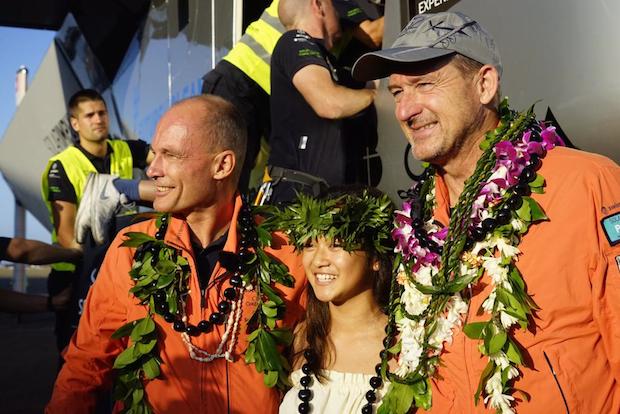Solar plane completes historic journey to Hawaii
A solar powered plane completed a historic journey from Japan to Hawaii Friday, breaking the record for the longest flight of an aircraft fueled entirely by the sun.
Solar Impulse 2, which had been stuck in Japan for a month due to poor weather, landed without incident after nearly five days and five nights in the air. It was the longest leg of what is scheduled to be an around-the-world flight that began in Abu Dhabi March 9 and is expected to take more than five months.
With more than a hundred supporters including relatives looking on, pilot Andre Borschberg guided the plane onto the runway in Honolulu at 5:55 a.m. local time. Back at the control center in Monaco, members of the team celebrated with champagne.
That ended the leg of a journey that covered 5,120 miles.
"This flight to Hawaii is very challenging, but it's an incredibly powerful motivation to know that people are showing their support," said André Borschberg, co-founder, CEO and pilot of Solar Impulse said from his cockpit before landing.
The successful flight was a relief for a project that has been dogged by repeated delays.
The plane spent several weeks in China due to weather problems. It then left Nanjing, China, for Hawaii on May 31, but was diverted to an airport in Nagoya in central Japan on June 1 because a cold front threatened to block its way.
After repairing a wing damaged by wind gusts, the team waited in Nagoya for the right conditions to depart. They set off on their journey early Monday.
The successful flight should boost the credibility of the project, which is meant to raise the profile of renewable energy and clean power. The journey has been 12 years in the making and is a brainchild of Borschberg and his co-pilot Bertrand Piccard.
"It is just incredible. What a great achievement and a great day for Solar Impulse," said Prince Albert II of Monaco, a supporter of the project who watched the plane arrive from the Monaco control center.
"It's such a great project and such a great enterprise," he said. "I knew the difficulties and I knew there were tough times ahead. It will be such an incredible message and is already is with this beautiful Pacific leg completed. We have to keep going and keep pushing and keep supporting."
The flight was also a testament to engineers who built the plane, which flies at an altitude of around 28,000 feet during the day to catch the sun's rays and at night dip to around 5,000 feet.
The carbon fiber plane, which is tough as nails and 10 times lighter than the best glider, weighs about the same as a small van.
It also has a 72-meter (236-foot) wingspan that would rival a Boeing 747 and a 70-horsepower engine that is almost three times more efficient than a traditional engine. Lithium polymer batteries similar to those found in electric cars and computers also store the energy collected by 17,248 ultra efficient solar cells built into the wings, fuselage and horizontal tailplane.
It also demonstrates the moxie of Borschberg, a Swiss explorer who before this already had eight distance, altitude and duration records in a solar plane.
He spent the past several days in an unheated, 4-cubic-meter compartment, wearing a specially designed suit that protects him from temperatures that can range anywhere from -20 degrees Celsius (-4 degrees Fahrenheit) to as high as 30 degrees C (86 degrees F). He also was forced to wear an oxygen mask when the plane flew above 11,800 feet to help avoid altitude sickness. The plane, at one point, reached a height of about 26,250 feet, creating conditions comparable to those for climbers on Mount Everest.
He was awake most of the time, only taking 20-minute naps six to eight times a day. If he slept any longer, Borschberg feared the plane on autopilot could drift off its planned route, forcing him to "change course, change altitude."
To maintain his mental sharpness, Borschberg did yoga and mediation during the flight. And on his arrival, he was given a long massage since he had not stood for several days. Looking a little weary, he told reporters on the tarmac that he wasn't exhausted and could have kept flying further.
"We got so much support from so many people. It gave me so much energy," Borschberg said. "The project was carried by the by the people who believe it was the way to go ... It was a discovery on a personal level ...It was like a retreat."
Piccard, a hang-gliding pioneer who captained the first round-the-world balloon flight, will handle the next leg of the trip from Hawaii to Arizona. Piccard plans to use self-hypnosis to get him through the long flight.


